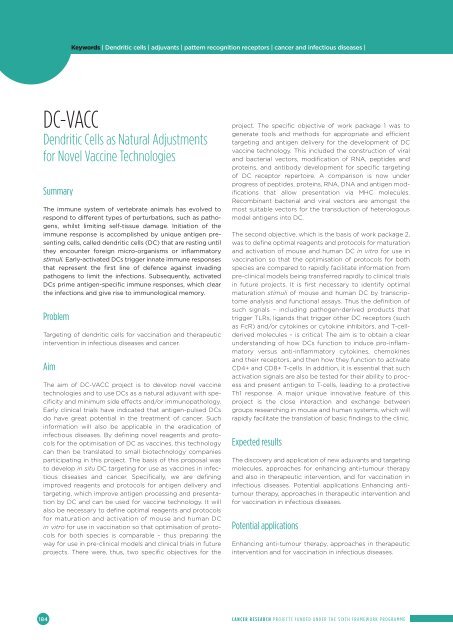You also want an ePaper? Increase the reach of your titles
YUMPU automatically turns print PDFs into web optimized ePapers that Google loves.
DC-VACC<br />
Dendritic Cells as Natural Adjustments<br />
for Novel Vaccine Technologies<br />
Summary<br />
The immune system of vertebrate animals has evolved to<br />
respond to diff erent types of perturbations, such as pathogens,<br />
whilst limiting self-tissue damage. Initiation of the<br />
immune response is accomplished by unique antigen presenting<br />
cells, called dendritic cells (DC) that are resting until<br />
they encounter foreign micro-organisms or infl ammatory<br />
stimuli. Early-activated DCs trigger innate immune responses<br />
that represent the fi rst line of defence against invading<br />
pathogens to limit the infections. Subsequently, activated<br />
DCs prime antigen-specifi c immune responses, which clear<br />
the infections and give rise to immunological memory.<br />
Problem<br />
Targeting of dendritic cells for vaccination and therapeutic<br />
intervention in infectious diseases and cancer.<br />
Aim<br />
Keywords | Dendritic cells | adjuvants | pattern recognition receptors | cancer and infectious diseases |<br />
The aim of DC-VACC project is to develop novel vaccine<br />
technologies and to use DCs as a natural adjuvant with specifi<br />
city and minimum side eff ects and/or immunopathology.<br />
Early clinical trials have indicated that antigen-pulsed DCs<br />
do have great potential in the treatment of cancer. Such<br />
information will also be applicable in the eradication of<br />
infectious diseases. By defi ning novel reagents and protocols<br />
for the optimisation of DC as vaccines, this technology<br />
can then be translated to small biotechnology companies<br />
participating in this project. The basis of this proposal was<br />
to develop in situ DC targeting for use as vaccines in infectious<br />
diseases and cancer. Specifi cally, we are defi ning<br />
improved reagents and protocols for antigen delivery and<br />
targeting, which improve antigen processing and presentation<br />
by DC and can be used for vaccine technology. It will<br />
also be necessary to defi ne optimal reagents and protocols<br />
for maturation and activation of mouse and human DC<br />
in vitro for use in vaccination so that optimisation of protocols<br />
for both species is comparable – thus preparing the<br />
way for use in pre-clinical models and clinical trials in future<br />
projects. There were, thus, two specifi c objectives for the<br />
project. The specifi c objective of work package 1 was to<br />
generate tools and methods for appropriate and effi cient<br />
targeting and antigen delivery for the development of DC<br />
vaccine technology. This included the construction of viral<br />
and bacterial vectors, modifi cation of RNA, peptides and<br />
proteins, and antibody development for specifi c targeting<br />
of DC receptor repertoire. A comparison is now under<br />
progress of peptides, proteins, RNA, DNA and antigen modifi<br />
cations that allow presentation via MHC molecules.<br />
Recombinant bacterial and viral vectors are amongst the<br />
most suitable vectors for the transduction of heterologous<br />
model antigens into DC.<br />
The second objective, which is the basis of work package 2,<br />
was to defi ne optimal reagents and protocols for maturation<br />
and activation of mouse and human DC in vitro for use in<br />
vaccination so that the optimisation of protocols for both<br />
species are compared to rapidly facilitate information from<br />
pre-clinical models being transferred rapidly to clinical trials<br />
in future projects. It is fi rst necessary to identify optimal<br />
maturation stimuli of mouse and human DC by transcriptome<br />
analysis and functional assays. Thus the defi nition of<br />
such signals – including pathogen-derived products that<br />
trigger TLRs, ligands that trigger other DC receptors (such<br />
as FcR) and/or cytokines or cytokine inhibitors, and T-cellderived<br />
molecules – is critical. The aim is to obtain a clear<br />
understanding of how DCs function to induce pro-infl ammatory<br />
versus anti-infl ammatory cytokines, chemokines<br />
and their receptors, and then how they function to activate<br />
CD4+ and CD8+ T-cells. In addition, it is essential that such<br />
activation signals are also be tested for their ability to process<br />
and present antigen to T-cells, leading to a protective<br />
Th1 response. A major unique innovative feature of this<br />
project is the close interaction and exchange between<br />
groups researching in mouse and human systems, which will<br />
rapidly facilitate the translation of basic fi ndings to the clinic.<br />
Expected results<br />
The discovery and application of new adjuvants and targeting<br />
molecules, approaches for enhancing anti-tumour therapy<br />
and also in therapeutic intervention, and for vaccination in<br />
infectious diseases. Potential applications Enhancing antitumour<br />
therapy, approaches in therapeutic intervention and<br />
for vaccination in infectious diseases.<br />
Potential applications<br />
Enhancing anti-tumour therapy, approaches in therapeutic<br />
intervention and for vaccination in infectious diseases.<br />
184 CANCER RESEARCH PROJECTS FUNDED UNDER THE SIXTH FRAMEWORK PROGRAMME
















